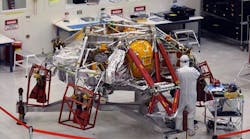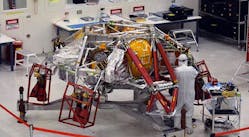The first planned assembly, test, and launch operations (ATLO) activities of the Mars 2020 mission will involve electrical integration of flight hardware into the descent stage. The Mars 2020 rover, as well as its cruise stage, aeroshell, and descent stage—a rocket-powered "sky crane" that will lower the rover to the planet's surface—will undergo final assembly at the Spacecraft Assembly Facility High Bay 1 at NASA’s Jet Propulsion Laboratory (JPL) in Pasadena, Calif. (Fig. 1).
1. A technician works on the descent stage for NASA’s Mars 2020 mission inside JPL’s Spacecraft Assembly Facility. Mars 2020 is slated to carry NASA’s next Mars rover to the Red Planet in July of 2020. (Credit: NASA/JPL-Caltech)
"No better place in the world to assemble NASA’s next Mars rover than JPL’s High Bay 1,” said Mars 2020 Project Manager John McNamee at JPL. "On the floor you’ll see the components of our spacecraft taking shape—put together by people who are the best in the world at what they do. And on the wall behind them you will see all the logos of the historic missions of exploration that have also been assembled in High Bay 1 in the past.”
Those missions include the Ranger missions to the moon (the first time America reached out and touched the moon), the Mariner mission to Venus (the first spacecraft to successfully encounter another planet), and Mars rovers.
Over the next year-and-a-half, engineers and technicians will add subsystems such as avionics, power, telecommunications, mechanisms, thermal systems, and navigation systems onto the spacecraft. The propulsion systems were installed earlier this year on the cruise and descent stage main structures.
“Parts of this mission are coming from the other side of the world, and some are coming from just ‘down the street’ in Pasadena, and some are coming from literally down the street—a couple of buildings away,” said David Gruel, ATLO Manager for Mars 2020 at JPL. “Right now we are working the descent stage, and by fall we expect to be working on the rover itself.”
Mars 2020 is targeted for launch in July 2020 aboard an Atlas V 541 rocket from Space Launch Complex 41 at Cape Canaveral Air Force Station in Florida. The rover will conduct geological assessments of its landing site on Mars, determine the habitability of the environment, search for signs of ancient Martian life, and assess natural resources and hazards for future human explorers. In addition, scientists will use the instruments aboard the rover to identify and collect samples of rock and soil, encase them in sealed tubes, and leave them on the surface of Mars for potential return to Earth by a future mission to the Red Planet.
The mission will build on the achievements of the Curiosity rover and other Mars Exploration Program missions. Furthermore, it will offer opportunities to deploy new capabilities developed through investments by NASA's Space Technology Program and Human Exploration and Operations Mission Directorate, as well as contributions from international partners.
The Mars 2020 Project at JPL manages the Mars 2020 spacecraft development for the Science Mission Directorate at NASA headquarters in Washington. NASA's Launch Services Program at Kennedy Space Center in Florida will manage and oversee the Atlas V launch service for Mars 2020.
The Marscopter Evolution
Started in August 2013 as a technology development project at JPL, the Mars Helicopter had to prove that big things could come in small packages. The result of the team’s four years of design, testing, and redesign weighs in at little under four pounds (1.8 kilograms). Its fuselage is about the size of a softball, and its twin, counter-rotating blades will bite into the thin Martian atmosphere at almost 3,000 rpm—about 10 times the rate of a helicopter on Earth.
“Exploring the Red Planet with NASA’s Mars Helicopter exemplifies a successful marriage of science and technology innovation, and is a unique opportunity to advance Mars exploration for the future,” said Thomas Zurbuchen, Associate Administrator for NASA's Science Mission Directorate at the agency headquarters in Washington. “After the Wright Brothers proved 117 years ago that powered, sustained, and controlled flight was possible here on Earth, another group of American pioneers may prove the same can be done on another world.”
2. The Mars Helicopter is a technology demonstration that will travel to the Red Planet with the Mars 2020 rover. It will attempt controlled flight in Mars' thin atmosphere, which, if successful, may enable more ambitious missions in the future. (Credit: NASA/JPL-Caltech)
The helicopter also contains built-in capabilities needed for operation at Mars, including solar cells to charge its lithium-ion batteries, and a heating mechanism to keep it warm through the cold Martian nights (Fig. 2). But before the helicopter can fly at Mars, it has to get there. It will do so attached to the belly pan of the Mars 2020 rover.
“The altitude record for a helicopter flying here on Earth is about 40,000 feet. The atmosphere of Mars is only 1% that of Earth, so when our helicopter is on the Martian surface, it’s already at the Earth equivalent of 100,000 feet up,” said Mimi Aung, Mars Helicopter project manager at JPL. “To make it fly at that low atmospheric density, we had to scrutinize everything, make it as light as possible while being as strong and as powerful as it can possibly be.”
Once the rover is on the planet’s surface, a suitable location will be found to deploy the helicopter down from the vehicle and place it onto the ground. The rover then will be driven away from the helicopter to a safe distance from which it will relay commands. After its batteries are charged and a myriad of tests are performed, controllers on Earth will command the Mars Helicopter to take its first autonomous flight into history.
“We don’t have a pilot and Earth will be several light minutes away, so there is no way to joystick this mission in real time,” said Aung. “Instead, we have an autonomous capability that will be able to receive and interpret commands from the ground, and then fly the mission on its own.”
The full 30-day flight test campaign will include up to five flights of incrementally farther flight distances, up to a few hundred meters, and longer durations as long as 90 seconds, over a period. On its first flight, the helicopter will make a short vertical climb to 10 feet (3 meters), where it will hover for about 30 seconds.
As a technology demonstration, the Mars Helicopter is considered a high-risk, high-reward project. If it doesn’t work, it will not impact the Mars 2020 mission. If it does work, helicopters may have a real future as low-flying scouts and aerial vehicles to access locations not reachable by ground travel.
“The ability to see clearly what lies beyond the next hill is crucial for future explorers,” said Zurbuchen. “We already have great views of Mars from the surface as well as from orbit. With the added dimension of a bird’s-eye view from a ‘marscopter,’ we can only imagine what future missions will achieve.”
Mars 2020 will launch on a United Launch Alliance (ULA) Atlas V rocket from Space Launch Complex 41 at Cape Canaveral Air Force Station in Florida. It’s expected to reach Mars in February 2021.



